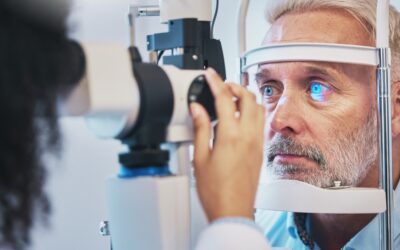Table of Contents
Childhood myopia, or nearsightedness, is a common eye health condition that makes far-away objects appear blurry to children. Experts believe it affects as many as 20% of students. While symptoms can vary, myopia often causes issues for school-age children with academic difficulties linked to poor vision.
Proper management strategies ensure there are no effects of poor eyesight on students, allowing these children to thrive academically. Recognizing the common signs of myopia is crucial to helping children at home and school.
Visiting an OKC children’s eye doctor will help develop a treatment and management plan adapted to the needs of each child, but recognizing the signs of myopia is often the first step in ensuring a child gets access to the eye health care they need.
Childhood Myopia Risk Factors
With over 200 genes linked to myopia, it’s no surprise that nearsightedness runs in some families.
Having parents or relatives with myopia doesn’t necessarily mean a child will develop this condition, but a children’s eye care doctor will establish a comprehensive medical history to assess each child’s risks.
The onset of myopia usually results from a mix of genetic and environmental factors. Among these factors, we find behaviors linked to the increased use of devices and screen time among children:
-
Prolonged Near-Sighted Activities — Reading is an excellent mind-building activity. However, long reading sessions can weaken the eye muscles needed for long-distance vision. Encourage children to take a break from reading about once every fifteen minutes. The same rule applies to screen time.
-
Diet — Research suggests that foods with a high-glycemic index could contribute to an underlying genetic predisposition to developing myopia. Examples include sugary foods and drinks, white bread, and potatoes.
-
Lack of Outdoor Activity — Spending time outside means children are more likely to focus on far-away objects than books or tablets. Scientists also believe that exposure to outdoor light could have a beneficial effect on eye health.
Signs and Symptoms of Myopia
Caregivers should be aware of the symptoms of myopia. These symptoms include blurred vision when gazing at distant objects, squinting for long periods producing headaches, and difficulty seeing in low-light environments.
In children, these symptoms can translate into frequent eye rubbing or a tendency to hold books and devices close to one’s face. At school, children with undiagnosed myopia might struggle with reading.
Treatment Options
If parents ask you about myopia diagnosis and treatment, let them know that a children’s eye doctor can diagnose myopia using techniques such as visual acuity, refraction, and slit-lamp exams. They will also rule out other eye conditions that can cause similar symptoms.
Once they know more about the child’s type and degree of nearsightedness, they will develop a plan to manage the symptoms and prevent myopia from worsening.
Eyeglasses
Eyeglasses with prescription lenses are the primary treatment option for children with myopia. These glasses use concave lenses thinner in the center and thicker on the edges.
These lenses adjust where light rays converge, allowing the convergence point to fall directly on the retina. This mechanism of action corrects blurriness, and the child doesn’t have to squint during lessons to see appropriately.
Contact Lenses
Thanks to recent innovations from contact lens manufacturers, a wide selection of soft and comfortable contact lenses are adapted to children and teens.
Contact lenses use a concave design similar to prescription eyeglasses, but they are more discreet and can feel more natural, and children of certain ages may prefer these over eyeglasses.
Regular Eye Exams
Scheduling regular eye exams is an essential aspect of managing myopia. An optometrist can monitor how the condition progresses and ensure that the child’s prescription still meets their needs.
They can also discuss screen time and other habits with parents and share tips for reducing eye strain in the home and classroom.
Making Eye Health Care Accessible
As a teacher, you can make a difference by watching out for the signs of myopia and communicating with parents.
Vision Care Direct makes children’s eyecare in OKC accessible and affordable through pre-paid vision plans. Learn more about our programs and how they can support children’s eye care access in OKC and nationwide.





















































